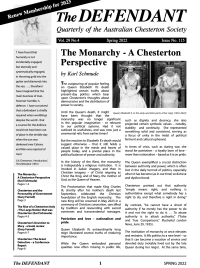A review of G.K. Chesterton and Our Lady: Readings and Essays on Chesterton’s Spiritual Life. Compiled and edited by Nancy Carpentier Brown, 2022. Available from The Society of Gilbert Keith Chesterton.

Reviewing this book was a challenge. The difficulty lay entirely with me.
The book is attractively presented with short chapters by a variety of engaging writers. Its sole subject is Gilbert Chesterton—whom I admire—and it focuses on only one aspect of Chesterton’s life, his adoration of Mary. The book has been skilfully edited by Nancy Carpentier Brown.
My difficulty is that I didn’t grow up Catholic and therefore the adoration of Mary is an exotic practice. Compounding my ignorance, I converted to Catholic in my mid-fifties — a few short years ago—and haven’t yet developed much in Mariology. If no book review is definitive, my review must remain distinctly tentative.
Mary the stranger
Like Frances Chesterton — Gilbert’s wife — for decades Anglicanism framed my Christian experience. Frances Chesterton’s experience was High Church Anglicanism featuring vestments, a formal liturgy, bells and smells, and Saints’ days with Mary being prominently honoured.
My Anglicanism was evangelical. The liturgy was informal; the sermon was the focus, not Holy Communion. We were wary of venerating saints lest they detract from Jesus.
Mary got only an honorary mention during Christmas services. She must decrease so Christ could increase.
In my many years attending Anglican churches I can’t remember one sermon about Mary. When I visited a Uniting Church the minister there preached on Mary, after admitting that it was the first time in his decades of ministry he would present a sermon on her. It was a refreshing, enlightening message. I’m thankful for it.
By that time I was already heading towards Catholicism and that Uniting Church minister helped smooth my way by highlighting Mary’s vitally important role in Christ’s life.
Mary everywhere
Chesterton’s books also smoothed my way. For example, in the Anglican Church aggrieved feminists—feeling under- appreciated and dishonoured—agitated for greater roles, for ordination and clerical advancement.
I’d noticed that sometimes their feminist beliefs tended to trump their Christian beliefs and I grew alarmed at their divisive, almost bullying agenda.
In contrast, as Chesterton highlighted, nobody could legitimately accuse Catholicism of neglecting or dishonouring women. Everywhere you looked in Catholic churches, chapels, schools and hospitals there was a statue, an image, a cult around women — Mary predominately, but lots of women saints as well.
Throughout Catholic history the female genius, virtues and special talents have been celebrated with no lapse into harmful ideology, unfaithful compromise or disrespect between men and women. Chesterton helped me see this remarkable, balanced complexity. Mary was crucial to the balance.
Chesterton’s deep respect for women was engendered by the example of his kind, loving, self-giving mother. This respect was reinforced by marriage to Frances, a wise, patient, endlessly helpful and loyal wife.
Underpinning his respect was his love for Mary, Mother of God, the unique woman whose vocation was to bear God and give Him to His creation.
I admit I have a lot to learn about Mary in particular and the communion of saints in general. This book has provided me with insight into Mary’s importance and the varieties of veneration: prayers, songs, poems, requests for interces- sion, feast days and emulation of her simplicity, humility and purity.
We see how important Mary was to Chesterton’s devotional life.
A Picture in chapters
The first three chapters, two by Nancy Brown and the third by Karl Schmude, provide an overview of the place of Mary in Chesterton’s spiritual life.
Karl admits that anyone’s spirituality must contain mystery, and Chesterton’s especially because he wrote so little about that aspect of his interior life. But he wrote more than enough about religion, philosophy and social concerns in poems, novels and essays that we can discern clear patterns.
Mary Romine contributes a chapter looking at Mary in Chesterton’s poems. The poems reveal his loyalty to Mary and the inspiration for his life he derived from her life.
I’ve come late to appreciate Chesterton’s poems, and this chapter together with other chapters by Nancy Brown and Peter Floriani assist with that poetry appreciation. They high- light poems I might not have otherwise encountered, or may have read without proper attention to Chesterton’s intention.
Sam Guzman and Fr. Robert Wild each contribute stirring, sly and valuable chapters into the life and world-changing potential of venerating Mary.
Surely it would cure many ills that now afflict our societies – from our troubled relation to nature to our view of courage and humility. Venerating Mary would also aid the return of an immensely beneficial code of chivalry. I enjoyed these witty, piercing pieces.
I was glad to read a chapter about Frances Chesterton because no story about Gilbert is complete without her. In addition, I like her short lyrical poetry. It’s accessible and honest. Devotion to Mary was natural to both Frances and Gilbert and perhaps it was one more reason for their happy marriage.
Chesterton fans will be rewarded by reading this meditation on his spiritual life, mostly revealed through his own writing.
Wisely, the authors avoid attempts at adventurous speculative psychology. They reveal what they can but leave intact the mystery of another person’s interior life.
